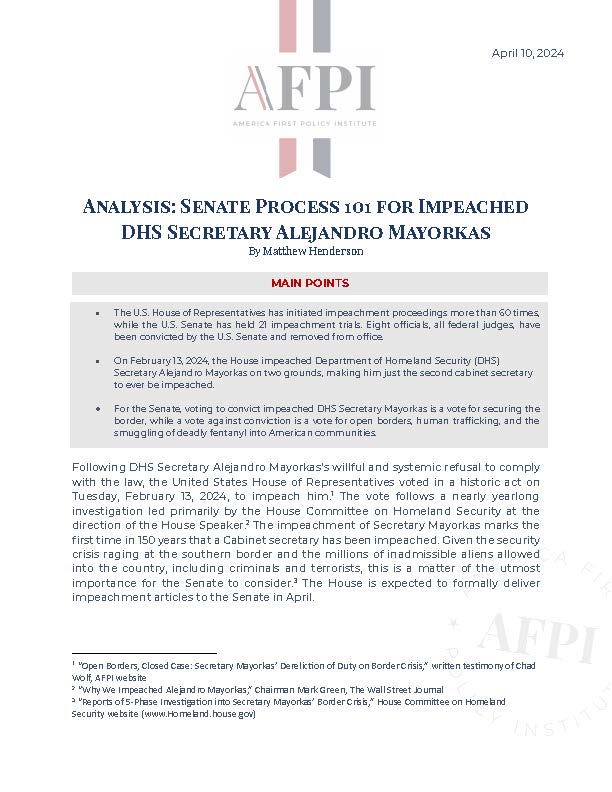Analysis: Senate Process 101 for Impeached DHS Secretary Alejandro Mayorkas
Key Takeaways
The U.S. House of Representatives has initiated impeachment proceedings more than 60 times, while the U.S. Senate has held 21 impeachment trials. Eight officials, all federal judges, have been convicted by the U.S. Senate and removed from office.
On February 13, 2024, the House impeached Department of Homeland Security (DHS) Secretary Alejandro Mayorkas on two grounds, making him just the second cabinet secretary to ever be impeached.
For the Senate, voting to convict impeached DHS Secretary Mayorkas is a vote for securing the border, while a vote against conviction is a vote for open borders, human trafficking, and the smuggling of deadly fentanyl into American communities.
Following DHS Secretary Alejandro Mayorkas’s willful and systemic refusal to comply with the law, the United States House of Representatives voted in a historic act on Tuesday, February 13, 2024, to impeach him.[1] The vote follows a nearly yearlong investigation led primarily by the House Committee on Homeland Security at the direction of the House Speaker.[2] The impeachment of Secretary Mayorkas marks the first time in 150 years that a Cabinet secretary has been impeached. Given the security crisis raging at the southern border and the millions of inadmissible aliens allowed into the country, including criminals and terrorists, this is a matter of the utmost importance for the Senate to consider.[3] The House is expected to formally deliver impeachment articles to the Senate in April.
Impeachment proceedings against Cabinet officials in the U.S. is rare.
Impeachment proceedings against Cabinet officials in the United States are rare. Article II, section 4 of the United States Constitution states that impeachment is a process used to charge, try, and remove federal officials for “Treason, Bribery, or other high Crimes and Misdemeanors,” a definition that has been long debated with no existing precedent. While most discussions historically about impeachment focus on presidents, the process can also apply to other federal officials, including judges and secretaries who are members of the President’s Cabinet. The last Cabinet secretary to be impeached was President Ulysses S. Grant's Secretary of War William Belknap in 1876.
Belknap was impeached for bribery and corruption, but he resigned before the impeachment vote. The Senate later acquitted him, and it was left unresolved whether they even had jurisdiction to convict a private citizen.
The House has initiated impeachment proceedings more than 60 times,[4] while the Senate has held 21 impeachment trials[5]. Just eight officials – all federal judges – have been convicted by the Senate and removed from office.
The specific rules and procedures for the impeachment trial will vary depending on the decisions made by the Senate.
It's important to note that the specific procedures and rules for an impeachment trial in the Senate may vary depending on the circumstances and the decisions made by the Senate majority leader. Traditional format for an impeachment trial follows the following format. Once delivered, the Senate must suspend legislative and executive business and address the articles of impeachment.[6]
Impeachment: The House of Representatives initiated the impeachment process by voting on one or more articles of impeachment against the president, vice president, or other federal officials. If a simple majority of the House votes in favor of impeachment, the official is impeached.
Transmission to the Senate: The articles of impeachment are then transmitted to the Senate, where the trial takes place. The Senate, through the majority leader, sets the rules and procedures for the trial.
Trial: The trial begins in the Senate. The House impeachment managers act as prosecutors, while the impeached official's defense team presents the case for the defense. In 1934, the Senate adopted a new impeachment rule, “Rule XI” that allows the Senate to delegate a portion of the impeachment trial process to a committee.
Opening Statements and Presentation of Evidence: Both sides make opening statements outlining their arguments. The House impeachment managers present their case by giving evidence, calling witnesses, and making arguments. The defense team can cross-examine witnesses and give their evidence.
Senators' Questions: After the presentation of evidence, Senators have the opportunity to ask questions of both the House impeachment managers and the impeached official’s defense team. The questions are submitted in writing and read aloud by the Chief Justice.
Deliberation and Vote: After the trial concludes, the Senate deliberates in a closed session. After deliberation, the Senate votes on each article of impeachment. A two-thirds majority vote is required to convict and remove the impeached official from office.
Verdict: Article II, Section 4 of the Constitution gives Congress the authority to impeach and remove the President, Vice President, and all federal civil officers. So, if the official is convicted on any article of impeachment, they are immediately removed from office. The Senate may also vote to disqualify the impeached official from holding any future public office.
Voting to convict impeached DHS Secretary Mayorkas is a Vote for Border Security.
The security crisis raging on the southwestern border and refusal by impeached Secretary Mayorkas to enforce the law has precipitated in the worst border crisis in American history, including allowing criminals and security threats to pour across the border. The bottom line is that for the Senate, voting to convict impeached DHS Secretary Mayorkas is a vote for securing the border, while a vote against convicting impeached DHS Secretary Mayorkas is a vote for open borders, human trafficking, and the smuggling of deadly fentanyl in American communities.
[1] “Open Borders, Closed Case: Secretary Mayorkas’ Dereliction of Duty on Border Crisis,” written testimony of Chad Wolf, AFPI website
[2] “Why We Impeached Alejandro Mayorkas,” Chairman Mark Green, The Wall Street Journal
[3] “Reports of 5-Phase Investigation into Secretary Mayorkas’ Border Crisis,” House Committee on Homeland Security website (www.Homeland.house.gov)
[4] United States House of Representatives website (www.House.gov)
[5] United States Senate website (www.Senate.gov)
[6] Senate Manual containing the Standing Rules, Orders, Laws, and Resolutions Affecting Business of the United States Senate, Section 170-194, 117th Congress
